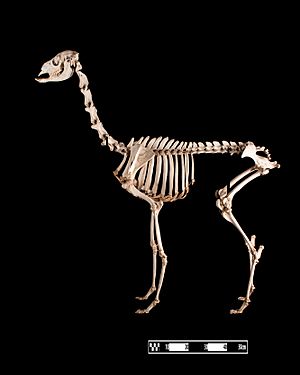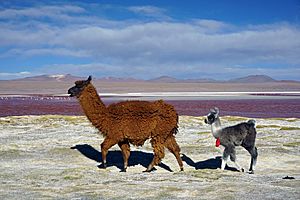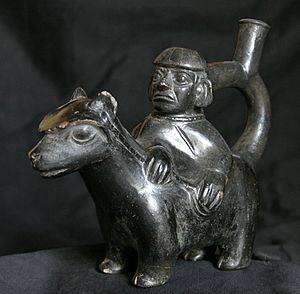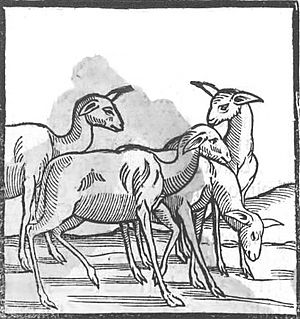Llama facts for kids
Quick facts for kids Llama |
|
|---|---|
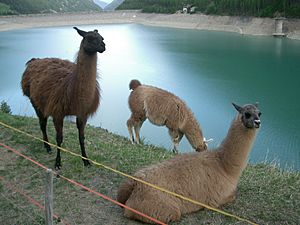 |
|
| Conservation status | |
| Scientific classification | |
 |
|
| Domestic llama and alpaca range | |
| Synonyms | |
|
Camelus glama Linnaeus, 1758 |
The llama (Lama glama) is a domesticated South American camelid, widely used as a meat and pack animal by Andean cultures since the Pre-Columbian era.
Llamas are social animals and live with others as a herd. Their wool is soft and contains only a small amount of lanolin. Llamas can learn simple tasks after a few repetitions. When using a pack, they can carry about 25 to 30% of their body weight for 8 to 13 km (5–8 miles). The name llama (in the past also spelled "lama" or "glama") was adopted by European settlers from native Peruvians.
The ancestors of llamas are thought to have originated from the Great Plains of North America about 40 million years ago, and subsequently migrated to South America about three million years ago during the Great American Interchange. By the end of the last ice age (10,000–12,000 years ago), camelids were extinct in North America. As of 2007, there were over seven million llamas and alpacas in South America and over 158,000 llamas and 100,000 alpacas, descended from progenitors imported late in the 20th century, in the United States and Canada.
In Aymara mythology, llamas are important beings. The Heavenly Llama is said to drink water from the ocean and urinates as it rains. According to Aymara eschatology, llamas will return to the water springs and lagoons where they come from at the end of time.
Contents
Characteristics
A full-grown llama can reach a height of 1.7 to 1.8 m (5 ft 7 in to 5 ft 11 in) at the top of the head, and can weigh between 130 and 272 kg (287 and 600 lb). At maturity, males can weigh 94.74 kg, while females can weigh 102.27 kg. At birth, a baby llama (called a cria) can weigh between 9 and 14 kg (20 and 31 lb). Llamas typically live for 15 to 25 years, with some individuals surviving 30 years or more.
The following characteristics apply especially to llamas. Dentition of adults: incisors 13 canines 11, premolars 22, molars 33; total 32. In the upper jaw, a compressed, sharp, pointed laniariform incisor near the hinder edge of the premaxilla is followed in the male at least by a moderate-sized, pointed, curved true canine in the anterior part of the maxilla. The isolated canine-like premolar that follows in the camels is not present. The teeth of the molar series, which are in contact with each other, consist of two very small premolars (the first almost rudimentary) and three broad molars, constructed generally like those of Camelus. In the lower jaw, the three incisors are long, spatulate, and procumbent; the outer ones are the smallest. Next to these is a curved, suberect canine, followed after an interval by an isolated minute and often deciduous simple conical premolar; then a contiguous series of one premolar and three molars, which differ from those of Camelus in having a small accessory column at the anterior outer edge.

The skull generally resembles that of Camelus, the larger brain-cavity and orbits, and less-developed cranial ridges being due to its smaller size. The nasal bones are shorter and broader, and are joined by the premaxilla.
- cervical 7,
- dorsal 12,
- lumbar 7,
- sacral 4,
- caudal 15 to 20.
The ears are rather long and slightly curved inward, characteristically known as "banana" shaped. There is no dorsal hump. The feet are narrow, the toes being more separated than in the camels, each having a distinct plantar pad. The tail is short, and fibre is long, woolly and soft.
In essential structural characteristics, as well as in general appearance and habits, all the animals of this genus very closely resemble each other, so whether they should be considered as belonging to one, two, or more species is a matter of controversy among naturalists.
The question is complicated by the circumstance of the great majority of individuals that have come under observation being either in a completely or partially domesticated state. Many are also descended from ancestors that have previously been domesticated, a state that tends to produce a certain amount of variation from the original type. The four forms commonly distinguished by the inhabitants of South America are recognized as distinct species, though with difficulties in defining their distinctive characteristics.
These are:
- the llama, Lama glama (Linnaeus);
- the alpaca, Vicugna pacos (Linnaeus);
- the guanaco (from the Quechua huanaco), Lama guanicoe (Müller); and
- the vicuña, Vicugna vicugna (Molina)
The llama and alpaca are only known in the domestic state, and are variable in size and of many colors, being often white, brown, or piebald. Some are grey or black. The guanaco and vicuña are wild. The guanaco is endangered; it has a nearly uniform light-brown color, passing into white below.
The guanaco and vicuña certainly differ from each other: The vicuña is smaller, more slender in its proportions, and has a shorter head than the guanaco.
The vicuña lives in herds on the bleak and elevated parts of the mountain range bordering the region of perpetual snow, amidst rocks and precipices, occurring in various suitable localities throughout Peru, in the southern part of Ecuador, and as far south as the middle of Bolivia. Its manners very much resemble those of the chamois of the European Alps; it is as vigilant, wild, and timid.
Vicuña fiber is extremely delicate and soft, and highly valued for the purposes of weaving, but the quantity that each animal produces is small. Alpacas are primarily descended from wild vicuña ancestors, while domesticated llamas are descended primarily from wild guanaco ancestors, although a considerable amount of hybridization between the two species has occurred.
Differential characteristics between llamas and alpacas include the llama's larger size, longer head, and curved ears. Alpaca fiber is generally more expensive, but not always more valuable. Alpacas tend to have a more consistent color throughout the body. The most apparent visual difference between llamas and camels is that camels have a hump or humps and llamas do not.
Llamas are not ruminants, pseudo-ruminants, or modified ruminants. They do have a complex three-compartment stomach that allows them to digest lower quality, high cellulose foods. The stomach compartments allow for fermentation of tough food stuffs, followed by regurgitation and re-chewing. Ruminants (cows, sheep, goats) have four compartments, whereas llamas have only three stomach compartments: the rumen, omasum, and abomasum.
In addition, the llama (and other camelids) have an extremely long and complex large intestine (colon). The large intestine's role in digestion is to reabsorb water, vitamins and electrolytes from food waste that is passing through it. The length of the llama's colon allows it to survive on much less water than other animals. This is a major advantage in arid climates where they live.
Reproduction
The gestation period of a llama is 11.5 months (350 days). Dams (female llamas) do not lick off their babies, as they have an attached tongue that does not reach outside of the mouth more than 13 millimetres (1⁄2 inch). Rather, they will nuzzle and hum to their newborns.
A cria (from Spanish for "baby") is the name for a baby llama, alpaca, vicuña, or guanaco. Crias are typically born with all the females of the herd gathering around, in an attempt to protect against the male llamas and potential predators. Llamas give birth standing. Birth is usually quick and problem-free, over in less than 30 minutes. Most births take place between 8 am and noon, during the warmer daylight hours. This may increase cria survival by reducing fatalities due to hypothermia during cold Andean nights. This birthing pattern is speculated to be a continuation of the birthing patterns observed in the wild. Crias are up and standing, walking and attempting to suckle within the first hour after birth. Crias are partially fed with llama milk that is lower in fat and salt and higher in phosphorus and calcium than cow or goat milk. A female llama will only produce about 60 millilitres (2 US fluid ounces) of milk at a time when she gives milk, so the cria must suckle frequently to receive the nutrients it requires.
Nutrition
Options for feeding llamas are quite wide; a wide variety of commercial and farm-based feeds are available. The major determining factors include feed cost, availability, nutrient balance and energy density required. Young, actively growing llamas require a greater concentration of nutrients than mature animals because of their smaller digestive tract capacities.
| Body weight (lb) |
Bromgrass | Alfalfa | Corn silage | |||
|---|---|---|---|---|---|---|
| (as fed) | (dry matter) | (as fed) | (dry matter) | (as fed) | (dry matter) | |
| 22 | 0.8 | 0.7 | 0.5 | 0.5 | 1.5 | 0.4 |
| 44 | 1.3 | 1.1 | 0.9 | 0.8 | 2.6 | 0.7 |
| 88 | 2.1 | 1.9 | 1.5 | 1.3 | 4.3 | 1.2 |
| 110 | 2.6 | 2.3 | 1.7 | 1.6 | 5.2 | 1.4 |
| 165 | 3.4 | 3.1 | 2.3 | 2.1 | 6.9 | 1.9 |
| 275 | 5.0 | 4.5 | 3.4 | 3.1 | 10.1 | 2.8 |
| 385 | 6.4 | 5.7 | 4.3 | 3.9 | 12.9 | 3.6 |
| 495 | 7.8 | 7.0 | 5.3 | 4.8 | 15.8 | 4.4 |
| 550 | 8.5 | 7.6 | 5.7 | 5.2 | 17.0 | 4.8 |
Behavior
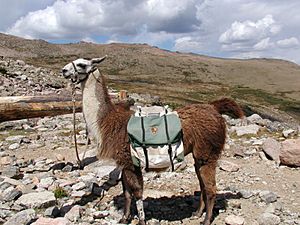
Llamas that are well-socialized and trained to halter and lead after weaning and are very friendly and pleasant to be around. They are extremely curious and most will approach people easily. However, llamas that are bottle-fed or over-socialized and over-handled as youth will become extremely difficult to handle when mature, when they will begin to treat humans as they treat each other, which is characterized by bouts of spitting, kicking and neck wrestling.
Llamas have started showing up in nursing homes and hospitals as certified therapy animals. Rojo the Llama, located in the Pacific Northwest was certified in 2008. The Mayo Clinic says animal-assisted therapy can reduce pain, depression, anxiety, and fatigue. This type of therapy is growing in popularity, and there are several organizations throughout the United States that participate.
When correctly reared, llamas spitting at a human is a rare thing. Llamas are very social herd animals, however, and do sometimes spit at each other as a way of disciplining lower-ranked llamas in the herd. A llama's social rank in a herd is never static. They can always move up or down in the social ladder by picking small fights. This is usually done between males to see which will become dominant. Their fights are visually dramatic, with spitting, ramming each other with their chests, neck wrestling and kicking, mainly to knock the other off balance. The females are usually only seen spitting as a means of controlling other herd members. One may determine how agitated the llama is by the materials in the spit. The more irritated the llama is, the further back into each of the three stomach compartments it will try to draw materials from for its spit.
While the social structure might always be changing, they live as a family and they do take care of each other. If one notices a strange noise or feels threatened, an alarm call - a loud, shrill sound which rhythmically rises and falls - is sent out and all others become alert. They will often hum to each other as a form of communication.
The sound of the llama making groaning noises or going "mwa" (/mwaʰ/) is often a sign of fear or anger. Unhappy or agitated llamas will lay their ears back, while ears being perked upwards is a sign of happiness or curiosity.
Guard behavior
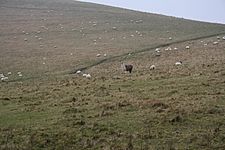
Using llamas as livestock guards in North America began in the early 1980s, and some sheep producers have used llamas successfully since then. Some would even use them to guard their smaller cousins, the alpaca. They are used most commonly in the western regions of the United States, where larger predators, such as coyotes and feral dogs, are prevalent.
Using llamas as guards has reduced the losses to predators for many producers. The value of the livestock saved each year more than exceeds the purchase cost and annual maintenance of a llama. Although not every llama is suited to the job, most are a viable, nonlethal alternative for reducing predation, requiring no training and little care.
Fiber
Llamas have a fine undercoat, which can be used for handicrafts and garments. The coarser outer guard hair is used for rugs, wall-hangings and lead ropes. The fiber comes in many different colors ranging from white or grey to reddish-brown, brown, dark brown and black.

| Animal | Fiber diameter (micrometres) |
|---|---|
| Vicuña | 6–10 |
| Alpaca (Suri) | 10–15 |
| Muskox (Qiviut) | 11–13 |
| Merino sheep | 12–20 |
| Angora rabbit (Angora wool) | 13 |
| Cashmere goat (Cashmere wool) | 15–19 |
| Yak (Yak fiber) | 15–19 |
| Camel (Camel hair) | 16–25 |
| Guanaco | 16–18 |
| Llama (Tapada) | 20–30 |
| Chinchilla | 21 |
| Angora goat (Mohair) | 25–45 |
| Huacaya alpaca | 27.7 |
| Llama (Ccara) | 30–40 |
Medical uses
Doctors and researches have determined that llamas possess antibodies that are well suited to treat certain diseases. Scientists have been studying the way llamas might contribute to the fight against coronaviruses, including MERS and SARS-CoV-2 (which causes COVID-19).
History of domestication
Pre-Incan cultures
Scholar Alex Chepstow-Lusty has argued that the switch from a hunter-gatherer lifestyle to widespread agriculture was only possible because of the use of llama dung as fertilizer.
The Moche people frequently placed llamas and llama parts in the burials of important people, as offerings or provisions for the afterlife. The Moche of pre-Columbian Peru depicted llamas quite realistically in their ceramics.
Inca Empire
In the Inca Empire, llamas were the only beasts of burden, and many of the people dominated by the Inca had long traditions of llama herding. For the Inca nobility, the llama was of symbolic significance, and llama figures were often buried with the dead. In South America, llamas are still used as beasts of burden, as well as for the production of fiber and meat.
The Inca deity Urcuchillay was depicted in the form of a multicolored llama.
Carl Troll has argued that the large numbers of llamas found in the southern Peruvian highlands were an important factor in the rise of the Inca Empire. It is worth considering the maximum extent of the Inca Empire roughly coincided with the greatest distribution of alpacas and llamas in Pre-Hispanic America. The link between the Andean biomes of puna and páramo, llama pastoralism and the Inca state is a matter of research.
Spanish Empire
One of the main uses for llamas at the time of the Spanish conquest was to bring down ore from the mines in the mountains. Gregory de Bolivar estimated that in his day, as many as 300,000 were employed in the transport of produce from the Potosí mines alone, but since the introduction of horses, mules, and donkeys, the importance of the llama as a beast of burden has greatly diminished.
According to Juan Ignacio Molina, the Dutch captain Joris van Spilbergen observed the use of hueques (possibly a llama type) by native Mapuches of Mocha Island as plow animals in 1614.
In Chile hueque populations declined towards extinction in the 16th and 17th century being replaced by European livestock. The causes of its extinction are not clear but it is known that the introduction of sheep caused some competition among both domestic species. Anecdotal evidence of the mid-17th century show that both species coexisted but suggests that there were many more sheep than hueques. The decline of hueques reached a point in the late 18th century when only the Mapuche from Mariquina and Huequén next to Angol raised the animal.
United States
Llamas were first imported into the US in the late 1800s as zoo exhibits. Restrictions on importation of livestock from South America due to hoof and mouth disease, combined with lack of commercial interest, resulted in the number of llamas staying low until the late 20th century. In the 1970s, interest in llamas as livestock began to grow, and the number of llamas increased as farmers bred and produced an increasing number of animals. Both the price and number of llamas in the US climbed rapidly in the 1980s and 1990s. With little market for llama fiber or meat in the US, and the value of guard llamas limited, the primary value in llamas was in breeding more animals, a classic sign of a speculative bubble in agriculture. By 2002, there were almost 145,000 llamas in the US according to the US Department of Agriculture, and animals sold for as much as $220,000. However, the lack of any end market for the animals resulted in a crash in both llama prices and the number of llamas; the Great Recession further dried up investment capital, and the number of llamas in the US began to decline as fewer animals were bred and older animals died of old age. By 2017, the number of llamas in the US had dropped below 40,000. A similar speculative bubble was experienced with the closely related alpaca, which burst shortly after the llama bubble.
Culture
Being an important animal and long standing cultural icon in South America, Llamas gained in recent history cultural prominence in Western culture.
For example the videogame company Maxis have used Llamas extensively as elements in their games, particularly in the widely popular game series The Sims, Llamas being the national symbol of the country the broader series of Sim games are set in. Also the programming language Perl with its so-called Llama book has been associated with Llamas.
See also
 In Spanish: Lama glama para niños
In Spanish: Lama glama para niños
- Alpaca
- Guanaco
- The Emperor's New Groove, a 2000 animated Disney film where an Incan emperor gets turned into a llama.



